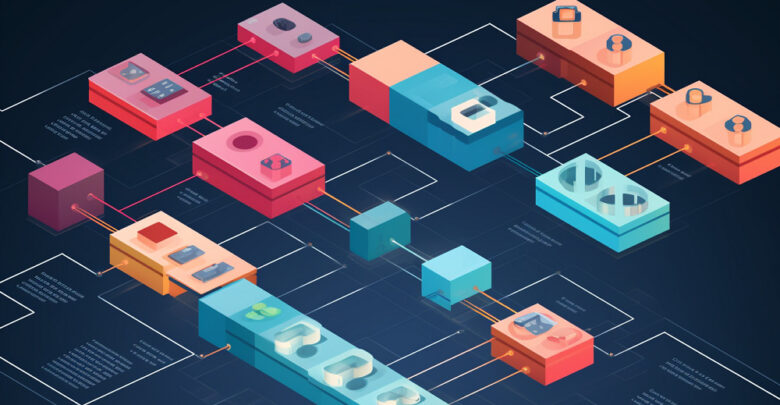Differences Between Monolithic And Modular Blockchains And How They Work

When it comes to blockchain technology, options are abundant, but each of these systems has its unique features. One way to classify these systems is by their blockchain architecture, which can be monolithic or modular.
These categories have many abilities, strengths, and potential weaknesses. An examination of the critical distinctions between modular and monolithic blockchain architectures will be discussed in this guide.
Monolithic Blockchain Explained
The introduction of monolithic blockchains marked the beginning of the blockchain and cryptocurrency industries. It also signals the emergence of the first generation of blockchain systems.
These pioneering systems, represented by the Bitcoin blockchain network, provided the framework for today’s disruptive blockchain technology. The architectural plan for monolithic blockchains is to combine core functionalities into a single layer of the blockchain structure.
This comprehensive layer combines transaction execution, consensus methods, and data availability. Furthermore, the monolithic chain is a settlement layer, monitoring transactions via on-chain validation.
Monolithic blockchains, which use a single database to store all network transactions, serve as comprehensive platforms for various functions such as information storage and sharing. However, despite their essential role in establishing the blockchain environment, monolithic blockchains have significant limits, particularly regarding adaptation and scalability.
Their inherent issues prompted the development of a new generation of blockchain systems known as modular blockchains.
How Monolithic Blockchains Work
Data Availability
Every transaction data is recorded directly on the Bitcoin blockchain. Thus, each node in the network has access to the entire transaction history. However, the blockchain’s public ledger stays completely accessible, and anyone who downloads the whole blockchain can view and verify the data, assuring its availability and integrity.
Transaction Execution
In the Bitcoin network, transaction execution refers to the processing and verification of transactions. When a user starts a Bitcoin transaction, it is broadcast to the network.
Nodes then accept responsibility for confirming their legality, such as maintaining an acceptable balance and putting it into a block. This sophisticated procedure comprises solving a cryptographic puzzle, which miners typically perform as part of the mining process.
Settlement
Settlement is the final step in Bitcoin transaction processing on the blockchain. A transaction achieves finality when included in a block, which is then added to the blockchain.
Once a transaction is recorded on the blockchain, it is immutable, making the process irreversible. As a result, the settlement layer is critical to the blockchain, ensuring that each transaction is permanent and unchangeable.
Consensus Mechanism
Bitcoin’s consensus mechanism is proof-of-work (PoW), where miners compete to solve complicated mathematical puzzles. The privilege of adding a new block of transactions to the blockchain is provided to the first miner who successfully solves the problem.
Nodes play a critical role by storing copies of the complete blockchain, authenticating and relaying transactions, and adding to the network’s general functionality and security. While specific nodes engage in mining tasks such as transaction validation and block addition, not all nodes function as miners.
Modular Blockchains Explained
Modular blockchain solutions differ substantially from monolithic ones by intentionally separating fundamental functionalities and spreading them across multiple levels. This architectural style maximizes efficiency and adaptability while accommodating a more comprehensive range of technologies and features.
The microservices design inherent in modular blockchains enhances adaptability by allowing alterations within particular levels without disturbing the complex balance of the entire network. The basic levels of modular blockchains are transaction execution, data availability, consensus, and settlement layers. This modular design increases flexibility and seamlessly integrates various technologies inside the blockchain ecosystem.
The Operations Of A Modular Blockchain
Here’s a breakdown of how Modular blockchains functions:
Transaction Execution
In the post-merger scenario, smart contracts are implemented and overseen by the Beacon Chain and shard chains. Most transaction processing and smart contract execution are delegated to smaller, alternative blockchains called shard chains, with the Beacon Chain as the network’s coordinator.
This deliberate segmentation improves scalability and processing efficiency, contrasting traditional monolithic designs.
Data Availability
Shard chains ensure data availability across the network. This solution ensures that data is consistently available and prevents limitations inside a single chain by spreading transaction demand across numerous shards.
This spread keeps data from being limited to a single chain and increases the network’s ability to expand and accommodate higher transaction volumes.
Settlement
Following Ethereum’s transition to PoS, the settlement layer was merged into the shard and beacon chains. This layer is responsible for resolving disputes and ensuring that transactions are final. Furthermore, it is critical for bridging transactions across many execution layers and evaluating proofs from shard chains.
Conclusion
Monolithic and modular designs may coexist soon. Monolithic chains’ security procedures and operational efficiency give them the upper hand.
However, modular alternatives could gain prominence in the blockchain environment as the demand for scalable and adaptable solutions rises. More importantly, security will be crucial to the viability of both blockchain systems, as their weaknesses can damage user confidence.
Tokenhell produces content exposure for over 5,000 crypto companies and you can be one of them too! Contact at info@tokenhell.com if you have any questions. Cryptocurrencies are highly volatile, conduct your own research before making any investment decisions. Some of the posts on this website are guest posts or paid posts that are not written by Tokenhell authors (namely Crypto Cable , Sponsored Articles and Press Release content) and the views expressed in these types of posts do not reflect the views of this website. Tokenhell is not responsible for the content, accuracy, quality, advertising, products or any other content or banners (ad space) posted on the site. Read full terms and conditions / disclaimer.




